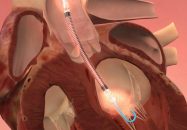While the rate of stroke has decreased since the early days of transcatheter aortic valve replacement (TAVR), it remains non-negligible, reaching up to 1%-3% at 30 days. As TAVR progressively expands to low-risk populations and younger patients, identifying risk factors for patient selection and management in stroke prevention becomes crucial. While researchers have identified predictors…
Low Gradient, Normal Flow Aortic Stenosis: Changes in Quality of Life with TAVR
There is no question as regards the recommended treatment for symptomatic severe aortic stenosis, seeing as both transcatheter and surgical aortic valve replacement (TAVR and SAVR) have shown to significantly improve prognosis. This is despite the fact that there is still certain ambiguity around its characterization, which looks to define it according to hemodynamic severity…
CAPTIS, a Novel Cerebral Embolic Protection System in TAVR
The incidence of stroke after TAVR ranges between 2 and 5%, depending on the series, which has been associated with higher morbimortality, affecting patient quality of life and their psycho-social environment. Many cerebral embolic protection systems have been developed in response, and even though they have been shown beneficial in many studies, their role in…
Is TAVR Beneficial in Cardiogenic Shock?
The presence of cardiogenic shock (CS) in a setting of aortic stenosis ranges from 1% to 4%. The prognosis for this scenario is ominous due to subendocardial ischemia, which presents as a decrease in ventricular preload and an increase in afterload. Aortic valvuloplasty has been used in this context, but, unfortunately, it has been associated…
Impella in High Risk Coronary Angioplasty before TAVR
The population is aging, which is closely related with the presence of aortic stenosis. This condition, as we know, is associated with coronary artery disease (CAD) approximately in 50% of cases. In high risk surgical patients, this calls for procedures such as percutaneous coronary intervention (PCI) and transcatheter aortic valve replacement (TAVR). PCI with ventricular…
TAVI-in-TAVI with Balloon-Expandable Valves
TAVI (Transcatheter Aortic Valve Implantation) has proven to be beneficial and is currently performed in increasingly younger and lower-risk patients. However, as with surgical bioprostheses, structural deterioration, whether due to stenosis or regurgitation, is one of the challenges we must address. While currently uncommon, this is an issue we will probably see more and more…
Post-TAVI Prosthesis-Patient Mismatch
Prosthesis-patient mismatch (PPM) occurs when the effective orifice area (EOA) after valve placement is significantly smaller compared with the patient’s body surface area (BSA), resulting in an increased transprosthetic residual gradient. The presence of PPM, especially in various surgical series, has been associated with long-term adverse clinical events. In relation to transcatheter aortic valve implantation…
TAVI in Moderate Aortic Stenosis with Low Ejection Fraction
The presence of aortic stenosis, heart failure, and decreased ventricular function is associated with poor prognosis and high mortality. For this reason, both European and American guidelines classify severe stenosis as a Class I indication. There are two retrospective analyses that demonstrate the benefits of transcatheter aortic valve implantation (TAVI) via transfemoral access. The TAVR…
Impact of Right Ventricular Pacing in Patients with Permanent Pacemaker Implantation after TAVR
Permanent pacemaker implantation (PPI) is a relevant complication in patients undergoing transcatheter aortic valve replacement (TAVR) despite there being new devices. The current information on the long term impact of this complication remains unclear and recent evidence suggests post-TAVR ventricular pacing (VP) might be associated to higher risk of all-cause mortality and hospitalization for cardiac…
EuroPCR 2023 | ACURATE Neo2: Results After 5 Years
The ACURATE Neo2 valve is an evolution of the first-generation ACURATE Neo valve with a low rate of pacemaker implantation and a decrease in paravalvular leak, also compatible with the 14F introducer. This prospective study included patients with symptomatic severe aortic stenosis at high surgical risk who underwent ACURATE Neo2 valve implantation. The primary endpoint…









